 W
WThe ARES FMG is a folding submachine gun designed by Francis J. Warin of Oak Harbor, Ohio, while he worked at Eugene Stoner's ARES Inc. Warin designed the gun for concealment and covert use, describing it as a “businessman’s personal defense weapon”. Allegedly, Warin had the idea of a defense weapon for VIPs and CEOs following the numbers of kidnappings of many of such persons in South America during the early 1980s. The FMG never entered full production.
 W
WAn assault rifle is a selective-fire rifle that uses an intermediate cartridge and a detachable magazine. Assault rifles were first put into mass production and accepted into widespread service during World War II. The first assault rifle to see major usage was the German StG 44, a development of the earlier Mkb 42. While immediately after World War II, NATO countries were equipped with battle rifles, the development of the M16 rifle during the Vietnam War prompted the adoption of assault rifles by the rest of NATO. By the end of the 20th century, assault rifles had become the standard weapon in most of the world's armies, replacing full-powered rifles and sub-machine guns in most roles. Some of the most successful assault rifles include the AK-47, M16, IMI Galil and Heckler & Koch G36.
 W
WA battle rifle is a service rifle chambered to fire a fully powered cartridge. The term "battle rifle" is a retronym created largely out of a need to better differentiate the intermediate-powered assault rifles from full-powered rifles as both classes of modern firearms have a similar appearance and share many of the same features such as detachable magazines, pistol grips, etc. Battle rifles were most prominent from the 1940s to the 1970s, when they were used as service rifles. While modern battle rifles largely resemble modern assault rifle designs, which replaced battle rifles in most roles, the term may also describe older military full-powered semi-automatic rifles such as the M1 Garand, SVT-40, Gewehr 43, FN Model 1949, and MAS-49.
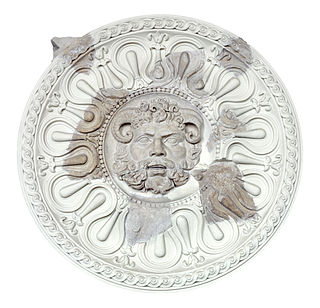 W
WIn the military of classical antiquity, a clipeus was a large shield worn by the Greek hoplites and Romans as a piece of defensive armor, which they carried upon the arm, to protect them from the blows of their enemies. It was round in shape and in the middle was a bolt of iron, or of some other metal, with a sharp point. The clipeus was more-or-less identical to the earlier aspis.
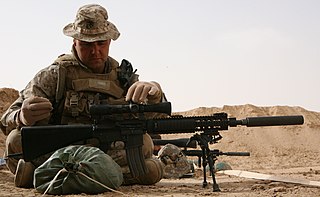 W
WA designated marksman rifle (DMR) is a modern scoped high-precision rifle used by infantrymen in the designated marksman (DM) role. It generally fills the engagement range gap between a standard service rifle and a dedicated sniper rifle, at around 300–600 metres (330–660 yd).
 W
WThe fascine knife was a side arm / tool issued to 17th to 19th century light infantry and artillery. It served both as a personal weapon and as a tool for cutting fascines. It could be straight or curved, double edged or single edged with a sawtoothed back.
 W
WThe fukiya (吹き矢) is the Japanese blowgun, as well as the term for the associated sport. It consists of a 1.2-metre-long tube, with darts approximately 20 centimetres (7.9 in) in length. Unlike modern Western blowguns, the fukiya has no mouthpiece: instead, a shooter must maintain a seal with the lips as he or she forcefully exhales. The darts used in the fukiya are called fukibari. Traditionally, fukibari were two inches in length.
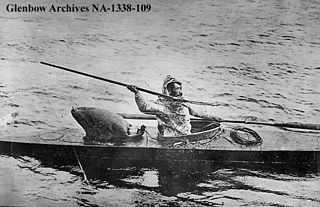 W
WA harpoon is a long spear-like instrument and tool used in fishing, whaling, sealing, and other marine hunting to catch large fish or marine mammals such as whales. It accomplishes this task by impaling the target animal and securing it with barb or toggling claws, allowing the fishermen to use a rope or chain attached to the projectile to catch the animal. A harpoon can also be used as a weapon.
 W
WThe Liberator is a physible (3D-printable) single shot handgun, the first such printable firearm design made widely available online. The open source firm Defense Distributed designed the gun and released the plans on the Internet on May 6, 2013. The plans were downloaded over 100,000 times in the two days before the United States Department of State demanded that Defense Distributed retract the plans.
 W
WA machine pistol is a self-loading pistol capable of burst or fully automatic fire. It can also be used to describe a stockless handgun-style submachine gun. The term is a calque of Maschinenpistole, the German word for submachine guns. Machine pistols were developed during World War I and originally issued to German artillery crews who needed a self-defense weapon that is lighter than a rifle but more powerful than a standard semi-automatic pistol. This concept would eventually lead to the development of the personal defense weapon or PDW. Today, machine pistols are considered special purpose weapons with limited utility, with their original niche being filled with either the PDW, carbines, or simply more modern semi-automatic sidearms. Contributing to their already-fringe use, without a shoulder stock and training, machine pistols can be difficult to control for all but the best shooters.
 W
WThe PAPOP was a French project to construct a computerised multi-usage infantry weapon for the FÉLIN system, capable of hitting hidden or protected targets. It would have combined a 35 mm grenade launcher with a 5.56×45mm NATO assault rifle, both in a bullpup configuration, complete with targeting aids.
 W
WThe sarisa or sarissa was a long spear or pike about 4–6 metres (13–20 ft) in length. It was introduced by Philip II of Macedon and was used in his Macedonian phalanxes as a replacement for the earlier dory, which was considerably shorter. These longer spears improved the strength of the phalanx by extending the rows of overlapping weapons projecting towards the enemy, and the word remained in use throughout the Byzantine years to sometimes describe the long spears of their own infantry.
 W
WA service pistol is any handgun or sidearm issued to regular military personnel or law enforcement officers. It is also known as a personal weapon or ordnance weapon.
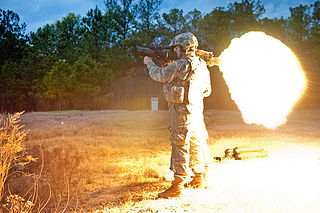 W
WA shoulder-fired missile, shoulder-launched missile, man-portable rocket launcher, or man-portable missile is a rocket-propelled explosive projectile small enough to be carried by a single person and fired while held on one's shoulder. The word "missile" in this context is used in its original broad sense of a heavy projectile, and encompasses all guided missiles and unguided rockets. In many instances, although not technically defining all shoulder-fired missiles, the name bazooka is regularly used as an informal name, although the actual Bazooka is a type of unguided rocket launcher in its own right.
 W
WA sidearm is a weapon, usually a handgun, but sometimes a knife, dagger, sword, bayonet, or other mêlée weapon, which is worn on the body in a holster or sheath to permit immediate access and use. A sidearm is typically required equipment for military officers and may be carried by law enforcement personnel. Usually, uniformed personnel of these services wear their weapons openly, while plainclothes personnel have their sidearms concealed under their clothes. A sidearm may be carried alone, or as a back-up to a primary weapon such as a carbine, rifle, shotgun, or submachine gun.
 W
WA slingshot is a small hand-powered projectile weapon. The classic form consists of a Y-shaped frame held in the non-dominant hand, with two natural-rubber strips or tubes attached to the upper two ends. The other ends of the strips lead back to a pocket that holds the projectile. The dominant hand grasps the pocket and draws it back to the desired extent to provide power for the projectile—up to a full span of the arm with sufficiently long bands.
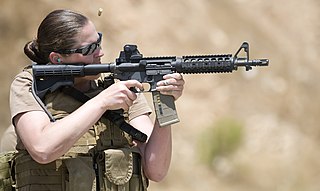 W
WA firearm is any type of gun designed to be readily carried and used by an individual. The term is legally defined further in different countries.
 W
WThe Sola is a submachine gun that was built by Societe Luxembourgeoise SA in Luxembourg between 1954 and 1957. It uses the 9×19mm Parabellum round and is capable of using MP 40-type magazines, which were popular around Europe at the time. This weapon saw service in Africa and several are still in use today.
 W
WThe XM29 OICW was a series of prototypes of a new type of assault rifle that fired 20 mm HE airbursting projectiles. The prototypes were developed as part of the Objective Individual Combat Weapon program in the 1990s. The term SABR was also used at certain points, but is less common.
 W
WThe xyston, a derivative of the verb ξύω "scrape, shave", was a type of a long thrusting spear in ancient Greece. It measured about 3.5–4.25 meters (11.5–13.9 ft) long and was probably held by the cavalryman with both hands, although the depiction of Alexander the Great's xyston on the Alexander Mosaic in Pompeii, suggests that it could also be used single handed. It had a wooden shaft and a spear-point at both ends. Possible reasons for the secondary spear-tip were that it acted partly as a counterweight and also served as a backup in case the xyston was broken in action. The xyston is usually mentioned in context with the hetairoi (ἑταῖροι), the cavalry forces of ancient Macedon. After Alexander the Great's death, the hetairoi were named xystophoroi because of their use of the xyston lance. In his Greek-written Bellum Judaicum, the Jewish historian Flavius Josephus uses the term xyston to describe the Roman throwing javelin, the pilum.